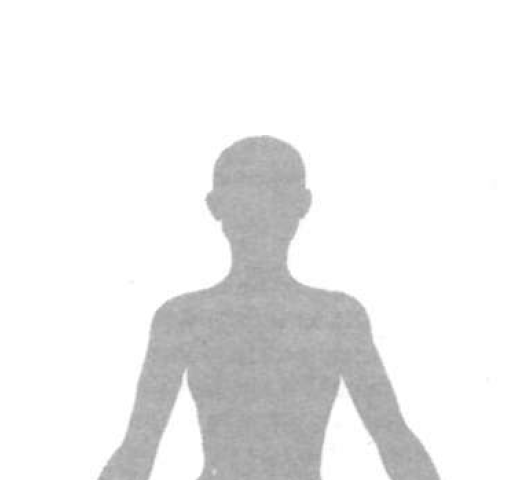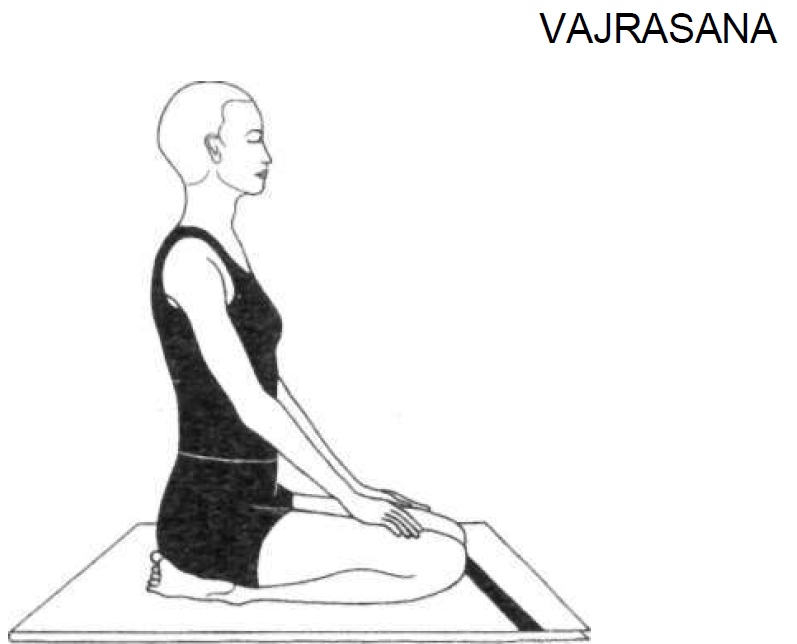Meditation Asanas
Yoga Asanas for Relaxation
September 1, 2016
Vajrasana for Healing
September 2, 2016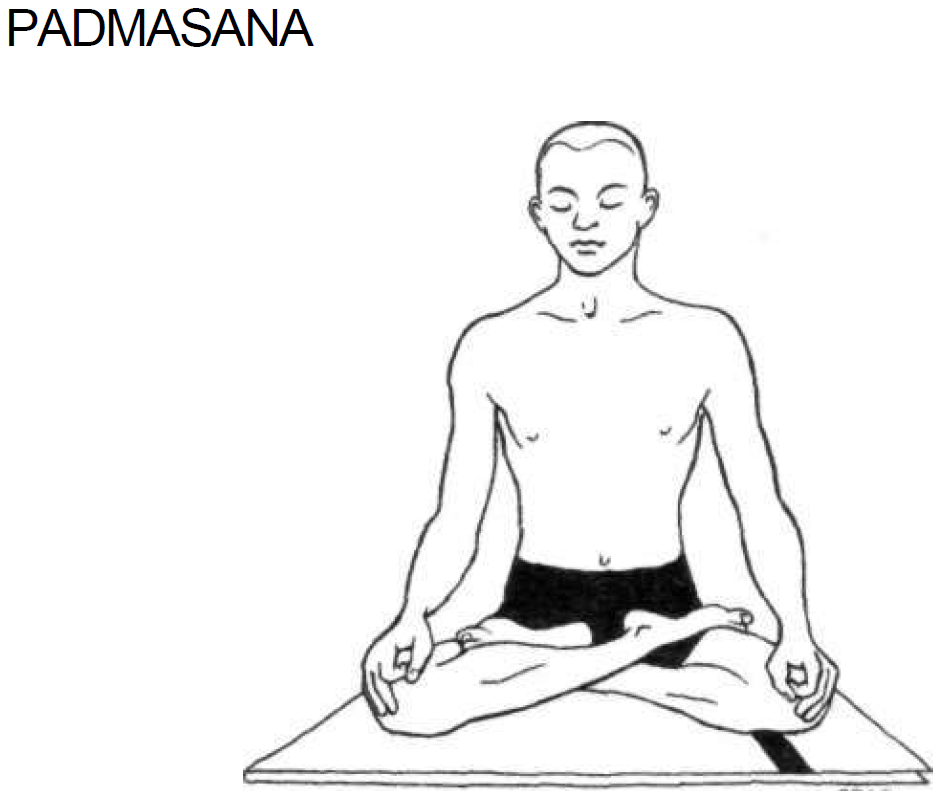
Padmasana (lotus pose) 3
Padmasana (lotus pose):-
Sit with the legs straight in front of the body.
Slowly and carefully bend one leg and place the foot on top of the opposite thigh.
The sole should face upward and the heel should be close to the pubic bone.
When this feels comfortable, bend the other leg and place the foot on top of the opposite thigh.
Both knees should, ideally, touch the ground in the final position.
The head and spine should be held upright and the shoulders relaxed.
Place the hands on the knees in chin or jnana mudra.
Relax the arms with the elbows slightly bent and check that the shoulders are not raised or hunched.
Close the eyes and relax the whole body.
Observe the total posture of the body. Make the necessary adjustments by moving forward or backward until balance and alignment are experienced. Perfect alignment indicates the correct posture of padmasana.
Contra-indications:
Those who suffer from sciatica, sacral infections or weak or injured knees should not perform this asana. This asana should not be attempted until flexibility of the knees has been developed through practice
of the pre-meditation asanas.Benefits:
Padmasana allows the body to be held completely steady for long periods of time. It holds the trunk and
head like a pillar with the legs as the firm foundation. As the body is steadied the mind becomes calm. This steadiness and calmness is the first step towards real meditation.Padmasana directs the flow of prana from mooladhara chakra in the perineum, to sahasrara chakra in the head, heightening the experience of meditation.
This posture applies pressure to the lower spine which has a relaxing effect on the nervous system. The breath becomes slow, muscular tension is decreased and blood pressure is reduced. The coccygeal and sacral nerves are toned as the normally large blood flow to the legs is redirected to the abdominal region. This activity also stimulates the digestive process.
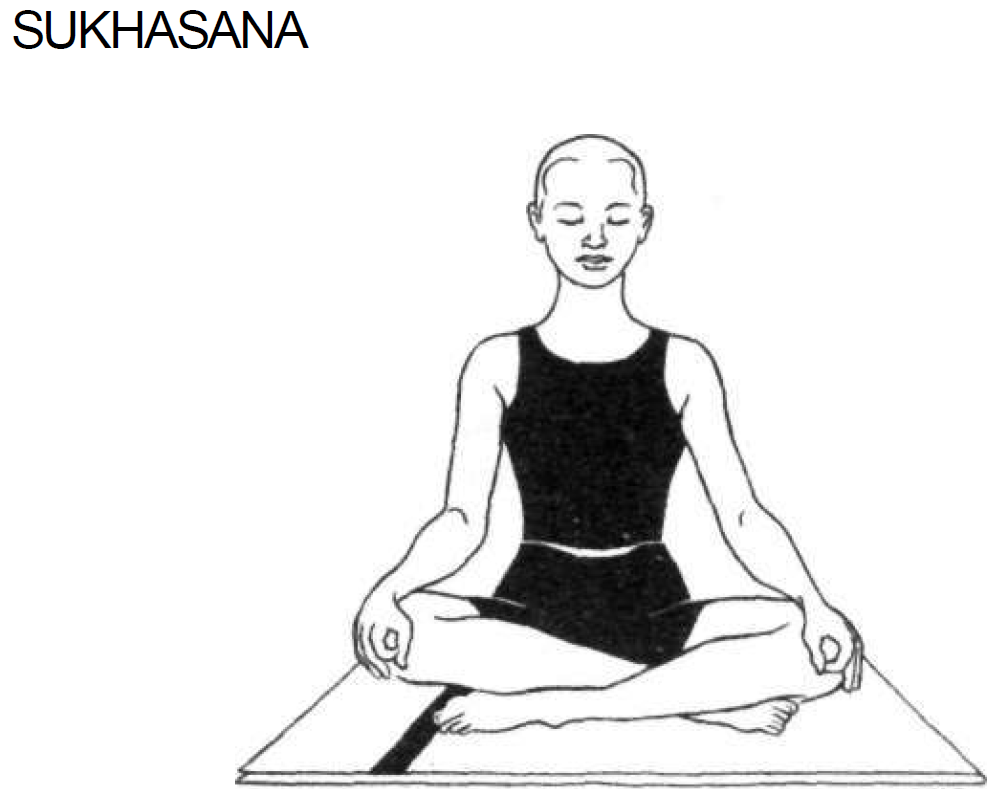
Sukhasana (easy pose) 1
Sukhasana (easy pose):-
Sit with the legs straight in front of the body.
Bend the right leg and place the foot under the left thigh.
Bend the left leg and place the foot under the right thigh.
Place the hands on the knees in chin or jnana mudra.
Keep the head, neck and back upright and straight, but without strain. Close the eyes.
Relax the whole body. The arms should be relaxed and not held straight.
Benefits:
Sukhasana is the easiest and most comfortable of the meditation postures. It can be utilised without ill effect by persons who are unable to sit in the more difficult meditation postures. It facilitates mental and physical balance without causing strain or pain.
Practice note:
Sukhasana is a relaxing posture which may be used after extended periods of sitting in siddhasana or
padmasana.Although sukhasana is said to be the simplest meditation posture, it is difficult to sustain for long periods of time unless the knees are close to the ground or on the ground. Otherwise most of the body weight is supported by the buttocks and backache develops. The other meditation asanas create a larger and, therefore, steadier area of support.
Variation: For those who are extremely stiff,
For those who are extremely stiff, sukhasana may be performed sitting cross-legged with a belt or cloth tied around the knees and lower back.
Hold the spine upright.
Concentrate on the physical balance and equalising the weight on the right and left side of the body. A light, spacey feeling may be experienced.
While maintaining the posture, place the hands on the knees in chin or jnana mudra.
http://selfhealingonline.com/offer-item/jnana-mudra-and-chin-mudra-41/
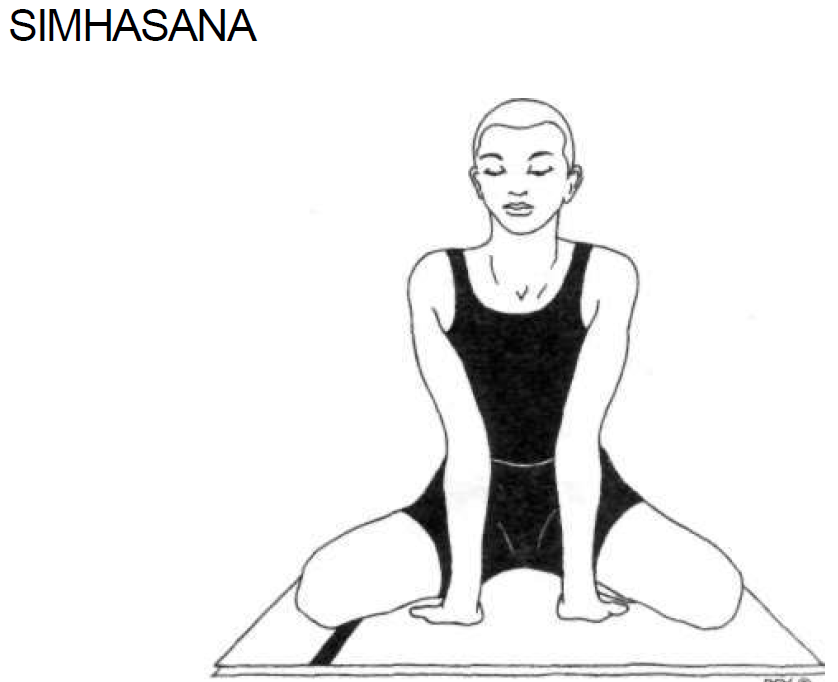
Simhasana (lion pose) 7
Simhasana (lion pose):-
Sit in vajrasana with the knees about 45 cm apart.
The toes of both feet should remain in contact with each other.
Lean forward and place the palms of the hands on the floor between the knees, with the fingers pointing towards the body.
Straighten the arms fully and arch the back, giving the maximum stretch to the front of the neck.
Rest the body on the straight arms.
Tilt the head back so that there is a comfortable amount of tension in the neck.
Close the eyes and focus the inner gaze at the eyebrow centre, performing shambhavi mudra.
The eyes may also be kept open, in which case gaze at a point on the ceiling.
The mouth should be closed.
Relax the whole body and mind.
Benefits:
In this posture there is a very definite extension of the spinal cord and the body is absolutely fixed. There is total physical stability; no one part bears the whole weight of the body. By focusing the inner gaze at the eyebrow centre, which represents the top of the spinal cord, the central nervous system is switched on, influencing the core structures around the hypothalamic-limbic system.
Alpha waves are generated in the optic system at the back of the head by closing the eyes. By crossing them in a meditative attitude, shambhavi mudra, these waves spread from the back of the head to the frontal lobes, producing a profound meditative or relaxed state very quickly. Following the principles of reflexology, it may be inferred that the strong pressure on the palms helps relieve stress and tension, improve blood supply, tone up the nerves and balance the vital energy necessary for mastering meditation techniques.
Note:
Generally, simhasana is associated with the roaring lion posture but the Upanishads give that posture as a variation of simhasana (see simhagarjana, the roaring lion, in the chapter Vajrasana Group of Asanas).
In this meditation asana the lion is sitting quietly, waiting for something to happen. This is the mental attitude the mind has to adopt in order to enter deep meditative states.
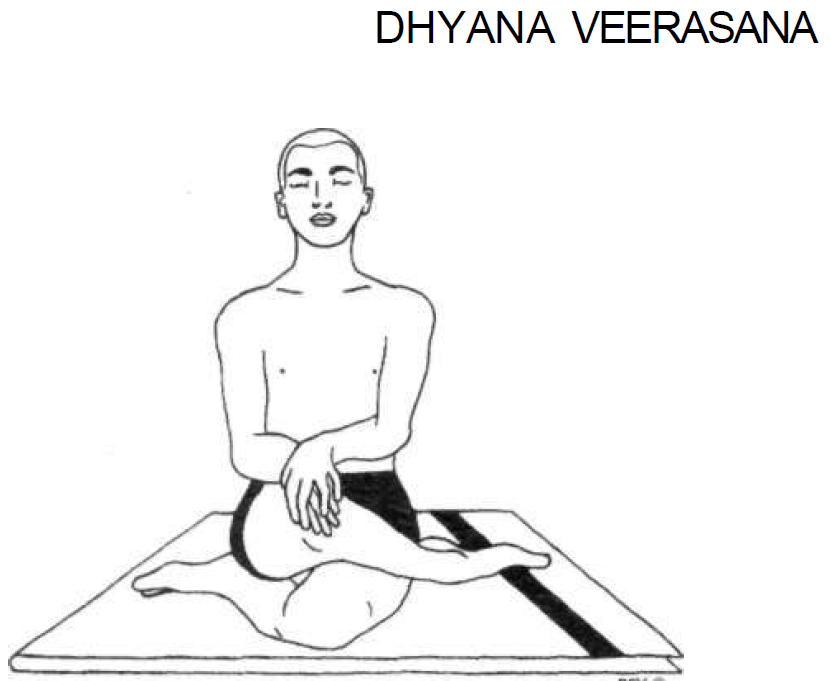
Dhyana Veerasana (hero’s meditation pose) 6
Dhyana Veerasana (hero’s meditation pose):-
Sit with both legs straight in front of the body.
Bend the left leg underneath the right leg so that the left heel is touching the right buttock.
Bring the right leg over the top of the bent left leg so that the right heel touches the left buttock.
Adjust the right knee so that it is above the left knee.
Place the hands either on the right knee, one on top of the other, or on top of each foot, whichever is comfortable.
Hold the head, neck and back straight.
Close the eyes and relax the whole body.
Be aware of the breath at the nose tip.
Benefits:
This asana is quite easy and comfortable to sustain for long periods of time as a comparatively large area of the body is in contact with the floor. It is a useful alternative to other meditation asanas. The legs and hips are not rotated outwards as in the other meditation postures, rather the knees are brought to the centre. This affects the pelvic structure and stretches the outer rather than the inner muscles of the thigh. This position also massages and tones the pelvic and reproductive organs.
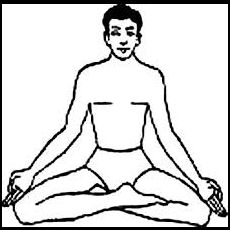
Swastikasana (auspicious pose) 5 a
Swastikasana (auspicious pose):-
Sit with the legs straight in front of the body.
Bend the left knee and place the sole of the left foot against the inside of the right thigh, so there is no contact between the heel and the perineum.
Bend the right knee and place the right foot in the space between the left thigh and calf muscle, so there is no contact between the heel and the pubis.
Grasp the toes of the left foot and pull them up into the space between the right calf and thigh.
Adjust the position so that it is comfortable. The knees should be firmly on the floor.
Straighten the spine.
Place the hands on the knees in chin, jnana or chinmaya mudra.
Variation:
Sit with the legs straight in front of the body.
Bend the left leg, place the sole against the inside of the right thigh.
Similarly, bend the right leg and place the heel of the right foot on the floor in front of the left foot with the sole resting against the left shin. The heels will now be one in front of the other.
The hands may be placed on the knees in jnana, chin or chinmaya mudra, or they may be placed on the lap.
Close the eyes and relax the whole body.
Contra-indications:
Swastikasana should not be performed by people with sciatica or sacral infections.
Benefits:
Swastikasana is a healthy position to sit in especially for those suffering from varicose veins, tired and aching muscles or fluid retention in the legs.
Practice note:
This is the easiest classical meditation asana and is a simplified version of siddhasana.
Note:
Here the symbol of the swastika represents the different corners of the earth and universe, the spokes, and their meeting point and common centre of consciousness. This asana may be regarded as the one most favourable for realising the unity of existence.
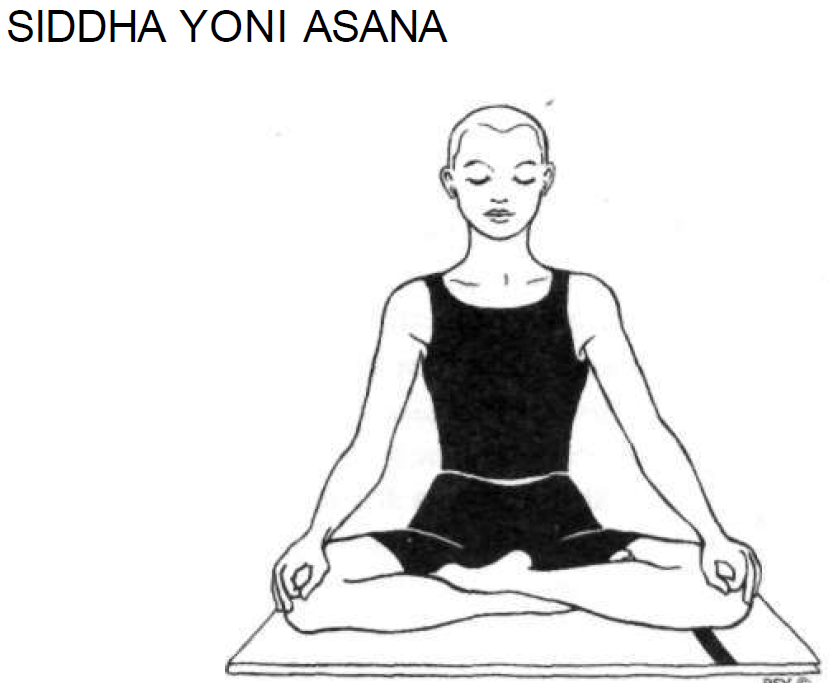
Siddha Yoni Asana (accomplished pose for women) 5
Siddha Yoni Asana (accomplished pose for women):-
Sit with the legs straight in front of the body.
Bend the right leg and place the sole of the foot flat against the inner left thigh.
Place this heel firmly against or inside the labia majora of the vagina.
Adjust the body position so that it is comfortable while simultaneously feeling the pressure of the right heel.
Bend the left leg and place the left heel directly on top of the right heel so it presses the clitoris, and wedge the left toes down into the space between the calf and thigh so they touch, or almost touch, the floor.
Grasp the toes of the right foot and pull them up into the space between the left calf and thigh.
Again, adjust the position so that it is comfortable.
Ensure that the knees are firmly on the ground.
Make the spine fully erect and straight as though it were planted solidly in the earth.
Place the hands on the knees is chin, jnana or chinmaya mudra.
Close the eyes and relax the whole body.
Contra-indications:
As for siddhasana.
Benefits:As for siddhasana.
Note:
The Sanskrit word yoni means womb’ or ‘source’.
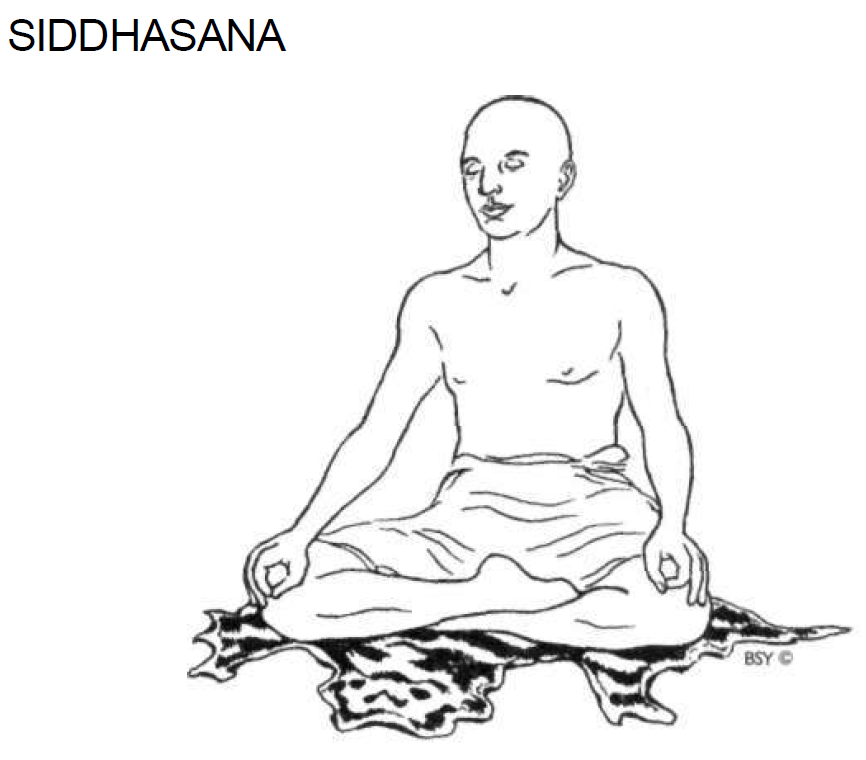
Siddhasana (accomplished pose for men) 4
Siddhasana (accomplished pose for men):-
Sit with the legs straight in front of the body.
Bend the right leg and place the sole of the foot flat against the inner left thigh with the heel pressing the
perineum (the area midway between the genitals and the anus), sitting on top of the right heel.This is an important aspect of siddhasana.
Adjust the body until it is comfortable and the pressure of the heel is firmly applied.
Bend the left leg and place the left ankle directly over the right ankle so that the ankle bones are touching and the heels are one above the other.
Press the pubis with the left heel directly above the genitals.
The genitals will, therefore, lie between the two heels.
If this last position is too difficult, simply place the left heel as near as possible to the pubis.
Push the toes and the outer edge of the left foot into the space between the right calf and thigh muscles. If necessary, this space may be enlarged slightly by using the hands or temporarily adjusting the position of the right leg.
Grasp the right toes and pull them up into the space between the left calf and thigh.
Again adjust the body so that it is comfortable.
The legs should now be locked, with the knees touching the ground and the left heel directly above the right heel.
Make the spine erect and feel as though the body is fixed on the floor. Place the hands on the knees in jnana, chin or chinmaya mudra.
http://selfhealingonline.com/offer-item/jnana-mudra-and-chin-mudra-41/
Close the eyes and relax the whole body.
Contra-indications:
Siddhasana should not be practised by those with sciatica or sacral infections.
Benefits:
Siddhasana directs the energy from the lower psychic centres upward through the spine, stimulating the brain and calming the entire nervous system. The position of the lower foot at the perineum presses mooladhara chakra, stimulating moola bandha, and the pressure applied to the pubic bone presses the trigger point for swadhisthana, automatically activating vajroli/sahajoli mudra. These two psycho-muscular locks redirect sexual nervous impulses back up the spinal cord to the brain, establishing control over the reproductive hormones which is necessary in order to maintain brahmacharya for spiritual purposes.
Prolonged periods in siddhasana result in noticeable tingling sensations in the mooladhara region which may last for ten to fifteen minutes. This is caused by a reduction in the blood supply to the area and by a rebalancing of the pranic flow in the lower chakras.
This posture redirects blood circulation to the lower spine and abdomen, toning the lumbar region of the spine, the pelvis and the abdominal organs, and balancing the reproductive system and the blood pressure.
Practice note:
Siddhasana may be performed with either leg uppermost. Many people experience discomfort due to
the pressure applied where the ankles cross each other. If necessary, place a folded cloth or piece of sponge between the legs at this point. At first the pressure at the perineum may be uncomfortable to maintain but with practice this will be eased.Note:
The Sanskrit word siddha means ‘power’ and ‘perfection’. The word siddhi is derived from siddha and refers to a psychic power or faculty developed through yogic practices. Siddhis include clairvoyance and telepathy as well as many other lesser known powers such as the ability to disappear at will. Siddhasana,
or siddha yoni asana for women, is believed to be the asana that helps develop these powers.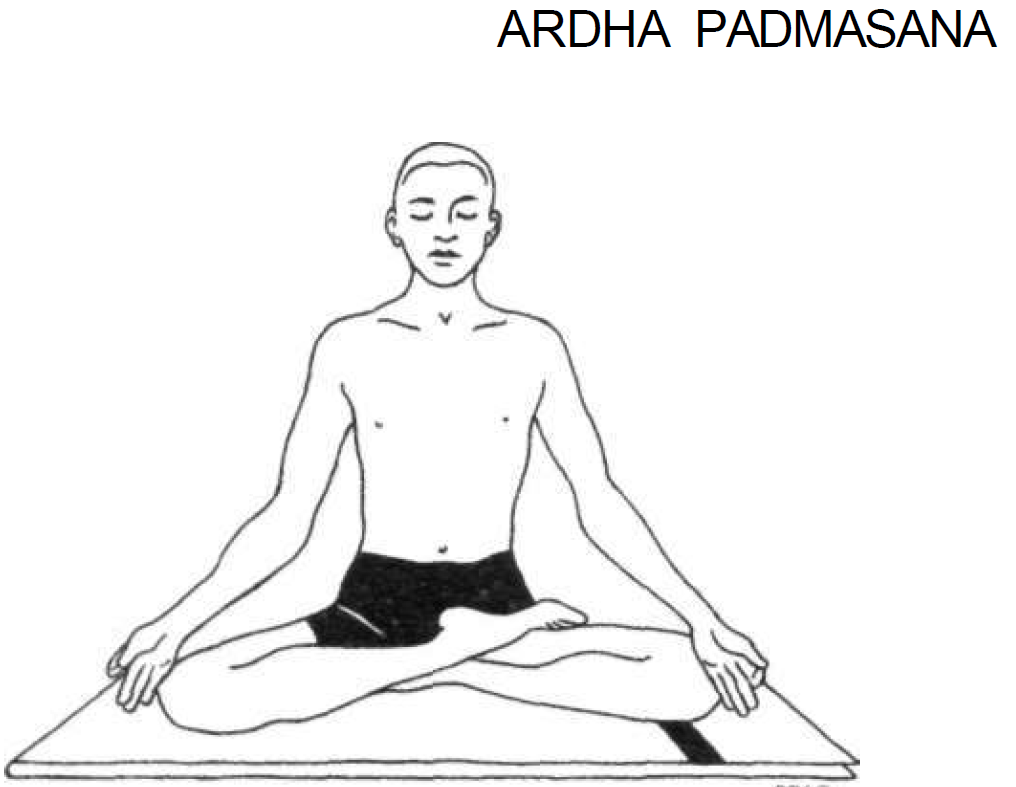
Ardha Padmasana (half-lotus pose) 2
Ardha Padmasana (half-lotus pose):-
Sit with the legs straight in front of the body.
Bend one leg and place the sole of the foot on the inside of the opposite thigh.
Bend the other leg and place the foot on top of the opposite thigh.
Without straining, try to place the upper heel as near as possible to the abdomen. Adjust the position so that it is comfortable.
Place the hands on the knees in either chin or jnana mudra.
http://selfhealingonline.com/offer-item/jnana-mudra-and-chin-mudra-41/
Keep the back, neck and head upright and straight.
Close the eyes and relax the whole body.
Contra-indications:
Those who suffer from sciatica or sacral ailments should not perform this asana.
Benefits:
The same as for padmasana but at a reduced level.
The main purpose of the healing meditation asanas is to allow them practitioner to sit for extended periods of time without moving the body and without discomfort. Only when the body has been steady and still for some time will meditation be experienced. Deep meditation requires the spinal column to
be straight and very few asanas can satisfy this condition.
Furthermore, in high stages of meditation the practitioner loses control over the muscles of the body. The meditation asana, therefore, needs to hold the body in a steady position without conscious effort. Why not lie in shavasana, then, for meditation since it satisfies all the requirements? Because in shavasana there is a tendency to drift into sleep. It is essential to remain awake and alert while going through the various stages which lead to successful meditation.
Stillness:
When sitting in meditation postures, programme the mind with suggestions like, “I am as steady as a rock” or “I am becoming motionless like a statue”. This way the asana will quickly become steady and, after a while, will be comfortable for extended periods of time. This is the practice of kaya sthairyam, complete body stillness.
Precautions:
If there is severe discomfort or pain in the legs after sitting for some time in a meditation asana, slowly
unlock the legs and massage them. When the blood circulation has returned to normal and there is no pain, resume the asana. However, be aware that the knee is a very delicate and much abused joint of the body and be careful not to strain it, especially while moving into or out of these meditation asanas. Do not on any account use undue force or strain to sit in a meditation asana.
Right or left leg: In all the asanas discussed in this chapter,
In all the asanas discussed in this chapter, either the left or the right leg may be placed uppermost. It is
a matter of personal preference and depends on whichever is the more comfortable. Ideally, the leg position should be alternated so that the balance on both sides of the body is maintained.
Practice note: A useful suggestion to make the following
A useful suggestion to make the following postures more comfortable is to place a small cushion under
the buttocks.
Note: Padmasana may seem out of place in the beginners’
Padmasana may seem out of place in the beginners’ group. It has been included, however, because a series of asanas in the intermediate group is performed using it as the base position.



